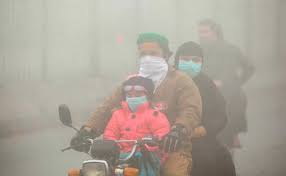 There is a class angle to the war against pollution in Delhi. And nobody is ready to talk about it. It is being waged every day – in media, judiciary, law enforcement, pollution masks and in AQI data. Both the privileged and the under-privileged contribute to the pollution and suffer from it, but the debate is dominated by the former.
There is a class angle to the war against pollution in Delhi. And nobody is ready to talk about it. It is being waged every day – in media, judiciary, law enforcement, pollution masks and in AQI data. Both the privileged and the under-privileged contribute to the pollution and suffer from it, but the debate is dominated by the former.
India’s mainstream media kicked off the debate this year by using government data that said 35 per cent of Delhi’s pollution is due to Punjab and Haryana farmers burning their straw stubble (the residue of rice plant called parali in local parlance). People in Delhi finally found the culprit responsible for the poor air quality in their city.
As is common with such identifications, culprits were caught and punished. Seventeen FIRs have been registered in Fatehabad district in Haryana alone as the number of FIRs in connection with stubble burning across Punjab and Haryana runs into hundreds. Haryana Police has formed special teams to identify farmers who pollute the air that residents of Delhi breathe. The Supreme Court and the National Green Tribunal have also come down heavily on the farmers. In 2017, more than 1,000 farmers in Haryana were fined for burning the stubble, with the government saying it was only following the Supreme Court order. Punjab has threatened farmers that they won’t get land on lease to cultivate next year if they are caught burning the stubble.
The mighty state, the Supreme court, and nearly every environmental institutions have been up in arms against farmers reportedly responsible for the one-third of Delhi’s pollution (as per government data).But what about the rest two-third of it?
Why don’t India’s courts and its governments (both central and states) show similar resoluteness in not only identifying but also penalising the culprits responsible for choking the lungs of Delhi’s residents rest of the year? Stubble burning can be blamed for the pollution in early winters. Is air pollution a seasonal problem in Delhi?Who pollutes Delhi’s air when farmers in Punjab and Haryana are not burning the stubble?
We know who else pollutes…..
The privileged gated communities of Delhi can arrange for private water (tankers of underground water), private electricity (back-up generators) and private security. They know how to exit the state and its inefficiencies. But air pollution is something that affects them, no matter how high their ivory towers go. That is why they have raised the pitch on the pollution debate, but in a way that absolves them and their own complicity. By entirely blaming the farmers from Punjab and Haryana.
It’s is not that we or the governments do not know the reason for pollution. If the government can tell us the exact share of stubble burning (35 per cent), then it must also know how much pollution Delhi’s residents cause by using their cars and air conditioners.
The Environment Pollution Control Authority has pointed out that vehicles contribute 40 per cent of the emission load in Delhi. Since all commercial vehicles in Delhi run on CNG, it’s private vehicles running on petrol and diesel, that are the main culprit for polluting Delhi’s air. Imagine the kind of outrage there will be if the government or the court passed an order mandating use of only CNG and LPG for cars on Delhi roads.
And what about firecrackers? Last year, 50,00,000 kilograms of firecrackers were burst on the day of Diwali in Delhi alone. Since there is a ban on sale of firecrackers in Delhi (except on the green ones especially developed by the Indian Council of Scientific and Industrial Research), the government acts against sellers and those bursting ‘illegal’ firecrackers. Interestingly, eco-friendly firecrackers are not completely green and they also pollute the air. This Diwali, 371 cases were registered with 166 people arrested and 3,500 kg of firecrackers seized, according to the Delhi Police.
But there is a stark difference between how the government acts against patakha and parali. The night of Diwali, the Air Quality Index (AQI) had hit 999, the maximum reading possible in the meter; Twitter was abuzz with the hashtag #CrackersWaliDiwali as people posted videos of themselves bursting firecrackers that are known to release more poisonous gases in the air. Not surprisingly, when media reports came out Wednesday about the rise in demand for pollution masks in Delhi, the blame once again went to the farmers, citing “government agencies”.
Courtesy The print















